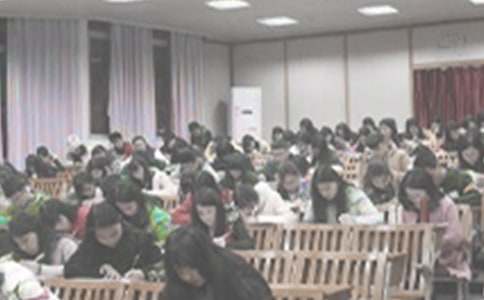- 相關(guān)推薦
2017年職稱英語考試試題衛(wèi)生A類閱讀理解復(fù)習(xí)題
Actively push yourself believe only can promote world, just push yourself can promote world.以下是小編為大家搜索整理的2017年職稱英語考試試題衛(wèi)生A類閱讀理解復(fù)習(xí)題,希望對正在關(guān)注的您有所幫助!更多精彩內(nèi)容請及時關(guān)注我們應(yīng)屆畢業(yè)生考試網(wǎng)!

Older Volcanic Eruptions
Volcanoes were more destructive in ancient history, not because they were bigger, but because the carbon dioxide they released wiped out life with greater ease.
Paul Wignall from the University of Leeds was investigating the link between volcanic eruptions and mass extinctions. Not all volcanic eruptions killed off large numbers of animals, but all the mass extinctions over the past 300 million years coincided with huge formations of volcanic rock. To his surprise, the older the massive volcanic eruptions were, the more damage they seemed to do. He calculated the "killing efficiency" for these volcanoes by comparing the proportion of life they killed off with the volume of lava that they produced. He found that for size, older eruptions were at least 10 times as effective at wiping out life as their more recent rivals.
The Permian extinction, for example, which happened 250 million years ago, is marked by floods of volcanic rock in Siberia that cover an area roughly the size of western Europe. Those volcanoes are thought to have pumped out about 10 gigatones of carbon as carbon dioxide. The global warming that followed wiped out 80 percent of all marine genera at the time, and it took 5 million years for the planet to recover. Yet 60 million years ago, there was another huge amount of volcanic activity and global warming but no mass extinction. Some animals did disappear but things returned to normal within ten thousands of years. "The most recent ones hardly have an effect at all," Wignall says. He ignored the extinction which wiped out the dinosaurs 65 million years ago, because many scientists believe it was primarily caused by the impact of an asteroid. He thinks that older volcanoes had more killing power because more recent life forms were better adapted to dealing with increased levels of CO2.
Vincent Courtillot, director of the Paris Geophysical Institute in France, says that Wignall's idea is provocative. But he says it is incredibly hard to do these sorts of calculations. He points out that the killing power of volcanic eruptions depends on how long they lasted. And it is impossible to tell whether the huge blasts lasted for thousands or millions of years. He also adds that it is difficult to estimate how much lava prehistoric volcanoes produced, and that lava volume may not necessarily correspond to carbon dioxide emissions.
1.Why did older volcanic eruptions do more damage than more recent ones?
A. Because they killed off life more easily.
B. Because they were brighter.
C. Because they were larger.
D. Because they were hotter.
2.How did Wignall calculate the killing power of those older volcanic eruptions?
A. By estimating how long they lasted.
B. By counting the dinosaurs they killed.
C. By studying the chemical composition of lava.
D. By comparing the proportion of life wiped out with the volume of lava produced.
3.When did dinosaurs become extinct?
A. 300 million years ago.
B. 250 million years ago.
C. 60 million years ago.
D. 65 million years ago.
4. What can be inferred from paragraph 3 concerning dinosaurs?
A. They were killed off by an asteroid.
B. They died of drastic climate change.
C. They were wiped offby a volcanic eruption.
D. The cause of their extinction has remained a controversial issue.
5.What is the main thesis of the article?
A. Volcanic eruptions are not always deadly.
B. Older volcanic eruptions were more destructive.
C. Carbon dioxide emissions often give rise to global warming.
D. It is not easy to calculate the killing power of a volcanic eruption.
參考答案
1.A。細節(jié)題。題干:為什么遠古的火山爆發(fā)比近期的火山爆發(fā)破壞性更大?利用題干關(guān)鍵詞可以定位到第一段:古代的火山更具破壞力,不是因為它們更大,而是因為它們釋放出的二氧化碳更能輕易地毀滅生命。
2.D。細節(jié)題。題干:Wignall是如何計算出遠古火山爆發(fā)的殺傷力的?利用題干關(guān)鍵詞可以定位到第二段。第二段有這樣一句話:He calculated the“killing efficiency'’for these volcanoes by comparing the proportion oflife they killed offwith the volume oflava that they produced.(他通過比較火山釋放出的熔巖的體積與殺死生命的比例計算這些火山的殺傷力)。
3.D。細節(jié)題。題干:恐龍是什么時候滅絕的?利用題干關(guān)鍵詞可以定位到第三段。其中有這么一句話:He ignored the extinction which wiped out the dinosaurs 65 million years ago,because many scientists believe it was primarily caused by the impact ofan asteroid.(他沒有提及6500萬年前恐龍的.滅絕,因為許多科學(xué)家相信恐龍的滅絕是受一顆小行星的影響)。
4.D。細節(jié)題。題干:從第三段還可以推導(dǎo)出有關(guān)恐龍的什么樣的信息?在討論第三題的答案時,我們已經(jīng)注意到了,Wignall沒有提6500萬年前恐龍的滅絕是否跟火山爆發(fā)有關(guān),因為許多科學(xué)家相信恐龍的滅絕是受一顆小行星的影響。這就說明,關(guān)于恐龍滅絕的原因在科學(xué)家之間是有爭議的。
5.B。主旨題。問題問的是:文章的主要論點是什么?答案在文章的第一句:Volcanoes were more destructive in ancient history(古代火山更具破壞力)。
【職稱英語考試試題衛(wèi)生A類閱讀理解復(fù)習(xí)題】相關(guān)文章:
職稱英語考試衛(wèi)生類C級閱讀理解習(xí)題201712-06
2015年職稱英語衛(wèi)生類A級試題之閱讀理解03-25
2015職稱英語《衛(wèi)生類》閱讀理解試題帶答案(一)03-28
職稱英語考試閱讀理解專項練習(xí)《衛(wèi)生A》03-30
2015年職稱英語《衛(wèi)生類》閱讀理解試題帶答案(四)03-28
職稱英語真題衛(wèi)生類A閱讀理解04-24
職稱英語考試衛(wèi)生類C級沖刺試題03-28